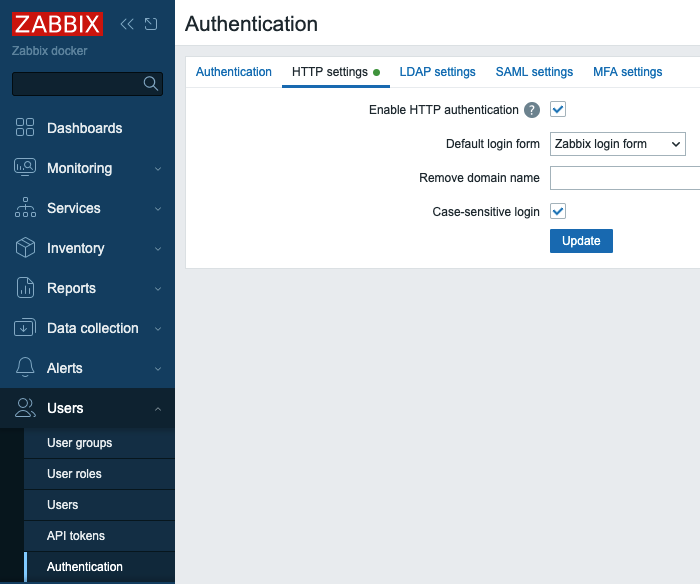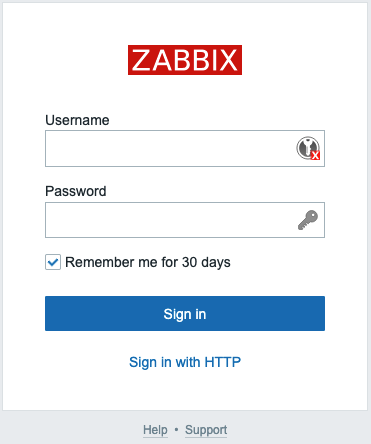HTTP
HTTP authenticatie is een van de externe authenticatiemethoden die Zabbix biedt en kan worden gebruikt om je Zabbix WebUI extra te beveiligen met een basisauthenticatiemechanisme op HTTP-serverniveau.
Basis HTTP authenticatie beschermt website (Zabbix WebUI) bronnen met een gebruikersnaam en wachtwoord. Wanneer een gebruiker toegang probeert te krijgen tot de Zabbix WebUI, zal de browser een dialoogvenster laten verschijnen waarin gevraagd wordt naar de gebruikersnaam en wachtwoord voordat er iets verzonden wordt naar de Zabbix WebUI php code.
Een HTTP-server heeft een bestand met referenties dat wordt gebruikt om gebruikers te authenticeren.
Note
IMPORTANT: usernames configured for basic authentication in HTTP server must exit in Zabbix. But only passwords configured in HTTP server are used for users authentication.
Laten we eerst eens kijken hoe we basisauthenticatie kunnen configureren in HTTP server.
Waarschuwing
The examples below provide just minimum set of options to configure
basic authentication. Please refer to respective HTTP server documentation
for more details
Basisauthenticatie in Nginx
Zoek location / { block in Nginx configuratiebestand dat je Zabbix WebUI
definieert (in mijn Zabbix implementatie is dat /etc/nginx/conf.d/nginx.conf
bestand) en voeg deze twee regels toe:
location / {
...
auth_basic "Basic Auth Protected Site";
auth_basic_user_file /etc/nginx/httpauth;
}
Vergeet niet om de Nginx service te herstarten na het maken van deze wijziging.
Dan moet je het bestand /etc/nginx/httpauth aanmaken dat het wachtwoord van
alle gebruikers bijhoudt (zorg ervoor dat je de toegang tot dit bestand
beperkt). Het formaat van dit bestand is gebruikersnaam:hashed_wachtwoord,
bijvoorbeeld voor gebruikers Admin en test:
Om hashed_password te genereren kun je openssl gebruiken en het wachtwoord
twee keer in voeren:
Basisverificatie in Apache HTTPD
Find <Directory "/usr/share/zabbix"> block in Apache HTTPD configuration file
that defines your Zabbix WebUI (in my case it is /etc/zabbix/apache.conf) and
add these lines:
???+ note By default configuration has Require all granted, remove this line.
For Ubuntu/Debian:
<Directory "/usr/share/zabbix">
...
AuthType Basic
AuthName "Restricted Content"
AuthUserFile /etc/apache2/.htpasswd
Require valid-user
</Directory>
For RedHat:
<Directory "/usr/share/zabbix">
...
AuthType Basic
AuthName "Restricted Content"
AuthUserFile /etc/httpd/.htpasswd
Require valid-user
</Directory>
Do not forget to restart apache2 service after making this change.
Create /etc/apache2/.httpasswd (/etc/httpd/.htpassword for RedHat) file that
will have all the users with passwords, do it by using htpasswd tool, to add
user test execute:
For Ubuntu/Debian
sudo htpasswd -c /etc/apache2/.htpasswd test
New password:
Re-type new password:
Adding password for user test
For RedHat
sudo htpasswd -c /etc/httpd/.htpasswd test
New password:
Re-type new password:
Adding password for user test
To add more users to the file repeat the command without -c flag.
Zabbix configuration for HTTP authentication
When we have a WEB server configured with basic authentication it is high time
to configure Zabbix server. In Zabbix menu select Users | Authentication | HTTP
settings and check Enable HTTP authentication check-box. Click Update and
confirm the changes by clicking OK button.

2.1 HTTP users authentication
Remove domain name field should have a comma separated list of domains that
Zabbix will remove from provided username, e.g. if a user enters "test@myzabbix"
or "myzabbix\test" and we have "myzabbix" in this field then the user will be
logged in with username "test".
Unchecking Case-sensitive login check-box will tell Zabbix to not pay
attention to capital/small letters in usernames, e.g. "tEst" and "test" will
become equally legitimate usernames even if in Zabbix we have only "test" user
configured.
Note that Default login form is set to "Zabbix login form". Now if you sign
out you will see "Sign in with HTTP" link below Username and Password fields. If
you click on the link you will be automatically logged in into Zabbix WebUI with
the same username you previously used. Or you can enter different Username and
Password and normally log in into Zabbix WebUI as different user.

2.2 HTTP users authentication login form
If you select "HTTP login form" in Default login form drop-down you won't see
standard Zabbix login form when you try to log out. You actually won't be able
to sign out unless your authentication session expires. The only way to sign out
is to clear cookies in your browser. Then you'll have to go through the Web
server basic authentication procedure again.
Conclusion
Configuring HTTP level authentication adds a critical layer of access control to your Zabbix Web UI by leveraging your web server's native authentication mechanisms. Whether using Nginx or Apache, this approach ensures that users are prompted for credentials before even reaching Zabbix, effectively guarding against unauthorized access at the HTTP entry point. Key considerations include ensuring that usernames used in the HTTP authentication are already defined within Zabbix itself only the password from the web server matters for credential checks and correctly setting up Zabbix's HTTP authentication settings (such as domain removal and case sensitivity options). By coordinating web server authentication settings with Zabbix's internal configuration, you can achieve seamless and secure user login workflows that blend frontend usability with robust protective measures.
Questions
-
What advantage does HTTP (web server based) authentication provide compared to Zabbix's internal authentication mechanism? (Consider protection at the web server layer before the user even reaches the Zabbix UI.)
-
Why is it essential that a user must exist in Zabbix even when HTTP authentication is enabled and why does the Zabbix password become irrelevant in that case?
-
What are the configuration options in Zabbix's frontend under “Administration → Authentication” for HTTP authentication, and how might each affect login behavior? Examples include enabling/disabling case sensitivity, domain stripping, and choice of login form.
-
Suppose you disable case sensitive logins and maintain both 'Admin' and 'admin' accounts in Zabbix. How will HTTP authentication behave, and what outcome should you expect?
-
Imagine troubleshooting a login failure when using HTTP authentication: What steps would you take to ensure the web server’s authentication is configured correctly before examining Zabbix settings?
-
From a security standpoint, when would HTTP authentication alone be insufficient and what other authentication methods (e.g., LDAP, SAML, MFA) might you layer on top for added security?